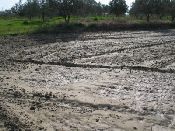| Stakeholders and their sustainability goals |
 |
|
Study site stakeholder workshops
Stakeholder groups
Sustainability Goals The analysis of the sustainability goals for protecting natural resources from land degradation and desertification was conducted following two main approaches: (a) farm survey, and (b) stakeholder workshop. The purpose of the farm survey was to collect data on indicators (Research Theme 2) and to discuss with individual farmers possible sustainability goals for environmental protection. The farm survey included informal discussions with the farmers related to: (a) the physical condition of the farm and the problems faced in crop production and loss in land productivity, (b) the impacts of land degradation and desertification on the physical environment and on the social and economical characteristics of the area, and (c) the possible actions and goals for protection and restoration of natural resources. The farm survey was conducted in two dominant land use types: (a) agricultural crops (olives and vines) and (b) and pastures. Forests are also important land uses in the island but these areas are strictly controlled by public agencies. These 7 sustainability goals were selected from 11 identified goals of sustainability for the study site of Crete. Considering the most important processes of degradation and existing actions or trends for sustainable use of natural resources more widely accepted by the local society, these 7 sustainability goals for land protection from desertification have been identified and proposed.
|
|||||||||||||||||||||||
Study sites

Acknowledgement
The DESIRE project was
|
DESIRE brought together the expertise of
26 international research institutes
and non-governmental organisations.
This website does not necessarily
represent the opinion of the
European Commission. The European
Commission is not responsible for
any use that might be made of the
information contained herein. 

